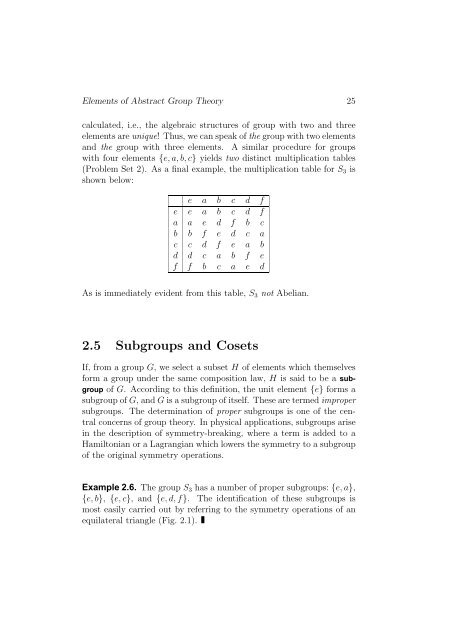Chapter 2 Elements of Abstract Group Theory
Chapter 2 Elements of Abstract Group Theory
Chapter 2 Elements of Abstract Group Theory
Create successful ePaper yourself
Turn your PDF publications into a flip-book with our unique Google optimized e-Paper software.
<strong>Elements</strong> <strong>of</strong> <strong>Abstract</strong> <strong>Group</strong> <strong>Theory</strong> 25<br />
calculated, i.e., the algebraic structures <strong>of</strong> group with two and three<br />
elements are unique! Thus, we can speak <strong>of</strong> the group with two elements<br />
and the group with three elements. A similar procedure for groups<br />
with four elements {e, a, b, c} yields two distinct multiplication tables<br />
(Problem Set 2). As a final example, the multiplication table for S3 is<br />
shown below:<br />
e a b c d f<br />
e e a b c d f<br />
a a e d f b c<br />
b b f e d c a<br />
c c d f e a b<br />
d d c a b f e<br />
f f b c a e d<br />
As is immediately evident from this table, S3 not Abelian.<br />
2.5 Subgroups and Cosets<br />
If, from a group G, we select a subset H <strong>of</strong> elements which themselves<br />
form a group under the same composition law, H is said to be a subgroup<br />
<strong>of</strong> G. According to this definition, the unit element {e} forms a<br />
subgroup <strong>of</strong> G, and G is a subgroup <strong>of</strong> itself. These are termed improper<br />
subgroups. The determination <strong>of</strong> proper subgroups is one <strong>of</strong> the central<br />
concerns <strong>of</strong> group theory. In physical applications, subgroups arise<br />
in the description <strong>of</strong> symmetry-breaking, where a term is added to a<br />
Hamiltonian or a Lagrangian which lowers the symmetry to a subgroup<br />
<strong>of</strong> the original symmetry operations.<br />
Example 2.6. The group S3 has a number <strong>of</strong> proper subgroups: {e, a},<br />
{e, b}, {e, c}, and {e, d, f}. The identification <strong>of</strong> these subgroups is<br />
most easily carried out by referring to the symmetry operations <strong>of</strong> an<br />
equilateral triangle (Fig. 2.1).













